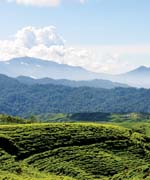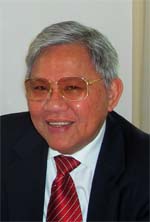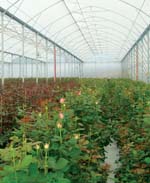The Asset December 2011 by Nina Pablo
 |
|
| Undulating green: The sprawling Nirmala Tea Estate is one of five estates acquired by the SariWangi Group in 2002 |
Indonesian tea company SariWangi Group has a grand vision for tea growing in Indonesia.
A fusion of advanced drip irrigation,
wireless sensors and specialized agronomy techniques could increase
yields by over 60% while decreasing fertilizer use by 50%, according to
Johan Alexander Supit.
The firm’s founder and chief executive
officer is confident that the innovation will revolutionize both
Indonesia’s agricultural sector as a whole and its growing and promising
tea industry in particular.
“With this new technology, our production capacity has gone up from 2,000 kilogrammes [of tea] per hectare per year to 3,000,” Supit says of the system’s effect on the estates in which they have tested it. “Our turnover, which used to be around US$2,500 per hectare, has grown to US$7,500 per hectare.”
The innovative technology has been used
in China and Thailand, but has never been applied in Indonesia nor in
any tea plantations. So great is it potential, that it has caught the
eye of CLSA Capital Partners. Their Clean Resources Asia Growth (CRAG)
Fund made an initial investment of US$15 million at the end of July 2011
in SariWangi Group, the largest single investment in sustainable
agriculture in Indonesia to date.
CLSA explains that innovations such as
these will become increasingly important, as food consumption is
expected to double by 2050 and input costs such as fertilizer have
increased over 400% in the past ten years. The funds will be used to
help grow Nutrigasi Indonesia – SariWangi Group’s agriculture technology
solutions company – and expand its core tea business.
Keeping up with the giants
The global (and Indonesian) tea industry has been looking strong the past three to four years, spurred by a greater desire in developed markets for healthy beverages and an increasing purchasing power from emerging economies. Business research group Economist Intelligence Unit found that global demand increased 34.2% from 2005 to 2010.
Prices of black tea, the most commonly
consumed tea and the bulk of SariWangi’s business, have risen from
US$1.63/kg to US$2.89/kg in the same period. From 2001 to 2010,
Indonesian demand has more than doubled from 39,431 tonnes to 87,128
tonnes.

Supit: We have everything here, all we have to do is make them work
However, the late 1990s to the early
2000s were difficult years for the Indonesian tea industry, and its
effects are still being felt to this day, according to Supit. “The
market was lousy; tea prices [in Indonesia] dropped below cost …
SariWangi Group survived because it had a lot of overseas blending and
distribution business,” he explains. “In 2007, there was an upturn
[followed by continuous growth], but by then a lot of tea estates in the
country had been abandoned.”
SariWangi Group has set its sights on
these abandoned tea estates, intending to maximize them to meet demand
that is suddenly, rapidly outstripping what Indonesia can currently
supply. “Instead of opening up new lands – which is time and capital
intensive – we can use the new system to increase production at the
existing tea plantations. This is what we did, and it really works.
Imagine, in 2006 our turnover was 13,500 tonnes. At the end of 2011, it
will be up to 42,000 tonnes.”
Sales of SariWangi tea have surged too,
from US$31.07 million at the end of 2009 to a forecast of US$85.23
million in 2011 – over 170% growth in just 2 years. Over 70% of their
business is overseas, blending and shipping teas to popular brands all
over the world (which, due to contract constraints, SariWangi could not
name), notably in the the Asia-Pacific, Russia, China, Middle East,
Europe and the US.
Such growth, while impressive, is
necessary if Indonesia wants to become a major player in the global tea
industry. Non-profit research organization the International Tea
Committee found that Indonesia produced roughly 140,000 tonnes in 2010,
well behind frontrunners such as China (1,350,000 tonnes), India
(980,000 tonnes), Kenya (520,000 tonnes), and Sri Lanka (300,000
tonnes).
While the numbers seem daunting, Supit
says Indonesia can keep up with these giants, because it still has great
untapped resources.
“India and Sri Lanka haven’t got much
space left to open up new plantations to keep up with their domestic and
overseas buyers’ demands … you see large companies like the ones in
India going around in Africa, looking for options to increase their
supply of tea. In Indonesia, we have the land, we have everything here,
all we have to do is make them work! … Our goal is to make Indonesia
[one of the centres] for tea supply in the world.”
One hurdle at a time
Supit has vast ambitions and intends to share this technology with Indonesian manufacturers of coffee and tea. He is aware, however, that such a vision could be difficult to implement, particularly in Indonesia, where a lot of tea estates have fallen into disrepair, where infrastructure and roads are underdeveloped, and regulations are slow in getting approval.
But he has no intention of letting any
of that deter him. SariWangi Group has thus far rolled out the new
system in some of their estates, with plans to implement it throughout
all their plantations within three years.
Government support, or lack thereof, is
foremost among the hurdles to this goal, particularly because there is
no infrastructure to keep up with the developing estates. “We cannot
build the roads; that has to be them. We must have access to the land to
do what we are going to do, and we need government support there too.”
He was unwilling to wait for them to
take the first step, but hopes that the continued strong performance of
and buzz about SariWangi Group’s new system will eventually attract
government attention. “We have to start; we’re not waiting for the
government to be interested. We are doing what we can.”
“[We are trying hard to push] the
efficiency of land and productivity. So much is wasted. Land is wasted.
Water is wasted. Everything is wasted. We constantly read in the papers
about the low productivity of Indonesian commodities,” he laments. “So I
asked my company, ‘Look, why don’t we do it?’ It won’t be a perfect
solution, but if we start something and people can see that we have done
something successfully, I think a lot of people will start to follow.”
Supit has been offering the technology
to smallholders (operators of micro tea plantations) as well, and he
hopes the benefits this can offer to them might help get the
government’s buy-in. One of his central goals over the next three years
is to pass the practice on to smallholders to maximize their lands and
production capacity. “There are [so many] smallholders where the
productivity is below 800 kg per hectare [making it difficult to be
profitable]. We could change that.”
Innovation through the years
SariWangi’s new system may be at its nascent stage, but the group is an old hand at innovating to stay competitive. As a tea group that started in 1962 with operations solely in trading, it has expanded over the years to become one of Indonesia’s industry leaders in blending and manufacturing tea.
 |
|
| Rose garden: A 1.2 ha green house of fresh cut roses – producing 5,000 stems per day – is part of an effort to optimize land usage at tea plantations |
At present, SariWangi Group is first in
Indonesia in terms of trading with 42,000 tonnes per year (37,000 of
which is black tea; the remainder green tea) and it is the largest
private company in plantation capacity with a production of 7,000 tonnes
per year (though distant from the government’s 35,000 tonnes per year);
and it is second only to Unilever in manufacturing with up to 15,000
tea bags a year.
This is a far cry from the group’s
considerably humbler beginnings, when Supit, who was trading tea
internationally for different companies in the 1960s, decided that he
should start building his own trading company with the industry
connections he had made over the years.
By the 1970s, however, multinational
companies began encroaching on his trading business as the industry
boomed, and Supit decided to create a more end-to-end tea company in
order to be able to work with these large firms instead of against them.
He explained this as “building
something from tea leaf to cup,” a motto that the company still stands
by today. SariWangi, in an effort to drive sales up, was responsible for
introducing tea bags in the 1980s to Indonesia, which prior to that had
only been using loose tea leaves.
Over the next twenty years, several
major deals and changes followed, including one in 1987 with industry
leader Unilever in which SariWangi Group sold their tea brand to them in
exchange for letting SariWangi Group exclusively manufacture it for
them, creating a decades-old partnership that has been profitable for
both.
SariWangi Group did a lot of trading
with Russian and Middle Eastern governments in the 1990s. It was when
state buying was banned that they began aggressively acquiring tea
estates to be able to create their own brands to sell to the private
sector.
The innovative technology and the
ambition to turn Indonesia into a centre for tea trade and improve its
agricultural industry has become the next step for the SariWangi Group
to grow. Supit knows that the road to these achievements is strewn with
obstacles, but he is in no hurry to get there. “We cannot do it
overnight; Rome was not built in one day,” he asserts. “We have
strategic movements to do it step by step.”
Source: The Asset